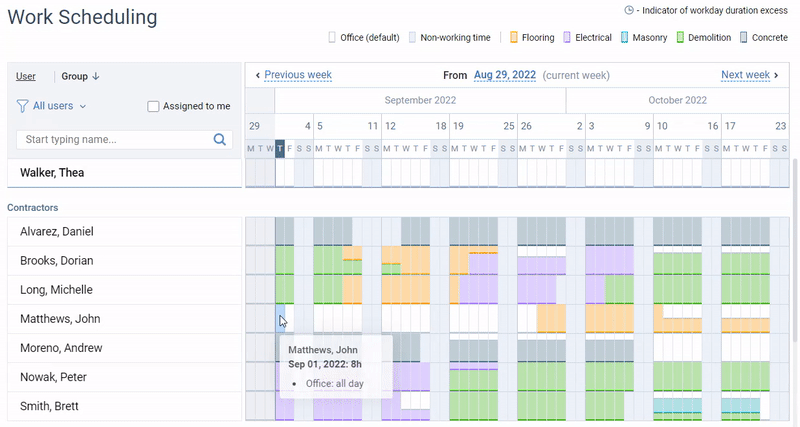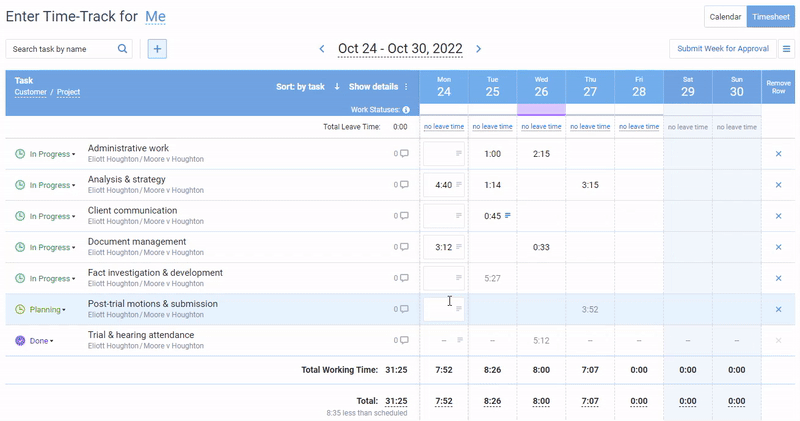Resource scheduling is all about figuring out what is needed to complete the project and where to find it. With all the necessary resources lined up, you hit deadlines, keep the quality high, and get the expected profits.
If you mess up your scheduling process, you end up with cost overruns, delays, and spoiled relationships with clients.
In this guide, we share a few doable tips on dealing with limited resources, managing project timelines, and creating effective resource schedules in a minimum of time.
Resource Scheduling Explained
Project resource scheduling is the process of planning and distributing people, equipment, materials, etc., to various tasks within a project. It helps ensure that the right resources are available at the right time and to the right employees.
To understand this definition better, let’s see what resource scheduling is not:
Example: Imagine a team of five people working on a marketing project.
- Emma – Graphic Designer
- Liam – Content Writer
- Sophia – Social Media Manager
- Noah – Web Developer
- Olivia – Project Manager
We know that:
- Emma is fully booked with visual assets for three campaigns. She has no remaining hours available.
- Liam has tasks assigned that fit within his available hours, completing all tasks with no remaining hours.
- Sophia has two tasks that she can manage within her schedule.
- Noah has enough time to complete both tasks without exceeding his availability.
- Olivia is managing the project and has allocated time for oversight and meetings.
An effective resource schedule will let the project manager assess each team member’s workload and ensure that all tasks are covered without overloading any individual.
Let’s see how to create one!
Project Resource Schedule Prerequisites
Before creating your schedule, it’s essential to gather the right information. It may vary depending on your project scope, but the general framework usually includes the following:
- People. Check out the project’s resource demand and see who’s available at the moment. Make a list that includes everyone’s names, their roles, and which team they’re currently in. Thus, you will easily spot if you need to bring in some fresh talent based on the skills required for the project.
- Costs and rates. Outline how much each resource costs per hour to learn if these costs are direct (the company’s tab) or billable (what clients are paying).
- Availability. Make sure your resource schedule clearly shows everyone’s availability, including planned holidays or any other important events. It will save you from the last-minute “Oops, I forgot I’m on vacation!” moments.
- Assignments. Make a list of specific tasks for each resource to help your team members understand what’s expected of them.
- Origins. Indicate your team members’ locations and if they’re contracted. Specify the type of contract they’re under. This information will help you manage logistics and communication more effectively.
Create a Project Resource Schedule in 5 Steps
With all the needed data at hand, you are ready to draw and fill your timeline.
Step 1: WBS
The Work Breakdown Structure (WBS) is your project’s roadmap. It helps you break down bigger goals into deliverables and then those deliverables into actionable tasks to pinpoint what exactly needs to be done and when.
At the end of this step, you’ll have a realistic task list that outlines everything your team needs to deliver.
Step 2: Project Timeline
This is where you’ll assign start and end dates to each task. When scheduling these, consider project priorities, dependencies, and resource availability.
Step 3: Assigning Tasks
When allocating work, consider both the skills and availability of your resources. Who has the right expertise? Are they free when you need them?
A visualization tool can help you see who’s doing what and when making scheduling a whole lot smoother.
Step 4: Tracking
Regular monitoring helps stay updated on how long tasks are actually taking, optimize resource utilization, and boost your project’s profitability.
Step 5: Adjustment
Keep an eye on your project’s progress and your team’s workload to spot issues—like over-allocation or resource shortages.
Once you identify gaps, you can adjust the schedule in a few ways:
• Reassign tasks: If someone’s swamped, see if you can shift some tasks around.
• Resource leveling: If clients are flexible, adjust start and end dates to balance workloads.
• Resource smoothing: If deadlines are set in stone, bring in extra help where needed.
Download your free resource schedule template here 👈
Dealing with Resource Constraints
No matter how good your schedule is, every project has its limits, and you’ll have to adjust to these.
First up, we have time-constrained scheduling. When your project has a tough deadline, the only thing you can do is hire more people to get the work done on time.
Picture this: a publishing house lands a new client but realizes they don’t have enough editors to release the book on the agreed date. What do they do? They hire some freelancers to help churn out that copy and keep the client happy.
Next, we’ve got resource-constrained scheduling. This method works well when your clients are not too obsessed with deadlines and project scope. So, you can either adjust your timeline or scale back what you’re delivering.
Let’s stick with our publishing house example. If they’re facing some resource shortages, instead of stressing out about meeting the original deadline, they might opt to deliver the first volume only. Clients are often more willing to tweak timelines than cut down on quality, so this approach can save your bacon.
Finally, we have cost-constrained scheduling. This is where things get a little more budget-focused. When money’s tight, you might need to rethink how you allocate your resources or even adjust the project scope.
Imagine our publishing house’s clients didn’t plan any editing at all. Then, you can persuade them to either reduce the number of copies they need or hire less expensive freelance writers.
Effective Resource Scheduling with actiPLANS
For example, actiPLANS is resource scheduling software that helps businesses manage time off, work shifts, project activities, employee locations, events, and more at a cost of $1.5 per user per month. With its assistance, you can easily process leave requests, auto-calculate everyone’s leave balances, review team availability, plan out project activities, schedule work shifts, and analyze resource utilization using reports.

Feel free to check out this post for more information on resource scheduling with actiPLANS 👈
actiPLANS also integrates with actiTIME – time and task management software. It lets you allocate project work to your team, keep track of employees’ attendance and working hours, monitor project costs and profits, and more.
 By combining actiTIME
By combining actiTIME


